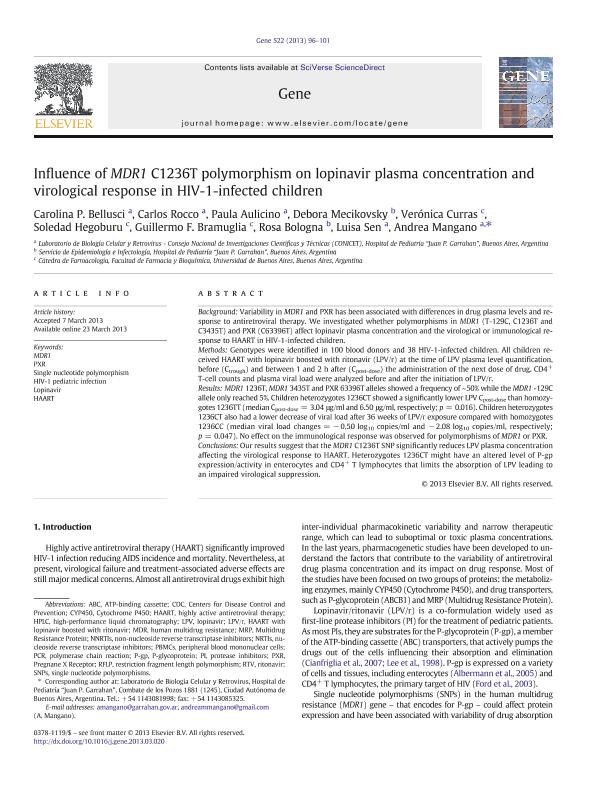Mostrar el registro sencillo del ítem
dc.contributor.author
Bellusci, Carolina Paula

dc.contributor.author
Rocco, Carlos Alberto

dc.contributor.author
Aulicino, Paula

dc.contributor.author
Mecikovsky, Debora

dc.contributor.author
Curras, Verónica
dc.contributor.author
Hegoburu, Soledad
dc.contributor.author
Bramuglia, Guillermo Federico

dc.contributor.author
Bologna, Rosa

dc.contributor.author
Sen, Luisa

dc.contributor.author
Mangano, Andrea María Mercedes

dc.date.available
2017-09-11T21:14:25Z
dc.date.issued
2013-06
dc.identifier.citation
Bellusci, Carolina Paula; Rocco, Carlos Alberto; Aulicino, Paula; Mecikovsky, Debora; Curras, Verónica; et al.; Influence of MDR1 C1236T polymorphism on lopinavir plasma concentration and virological response in HIV-1-infected children; Elsevier Science; Gene; 522; 1; 6-2013; 96-101
dc.identifier.issn
0378-1119
dc.identifier.uri
http://hdl.handle.net/11336/23952
dc.description.abstract
Background: Variability in MDR1 and PXR has been associated with differences in drug plasma levels and response to antiretroviral therapy. We investigated whether polymorphisms in MDR1 (T-129C, C1236T and C3435T) and PXR (C63396T) affect lopinavir plasma concentration and the virological or immunological response to HAART in HIV-1-infected children. Methods: Genotypes were identified in 100 blood donors and 38 HIV-1-infected children. All children received HAART with lopinavir boosted with ritonavir (LPV/r) at the time of LPV plasma level quantification, before (Ctrough) and between 1 and 2 h after (Cpost-dose) the administration of the next dose of drug. CD4+ T-cell counts and plasma viral load were analyzed before and after the initiation of LPV/r. Results: MDR1 1236T, MDR1 3435T and PXR 63396T alleles showed a frequency of ~ 50% while the MDR1 -129C allele only reached 5%. Children heterozygotes 1236CT showed a significantly lower LPV Cpost-dose than homozygotes 1236TT (median Cpost-dose = 3.04 μg/ml and 6.50 μg/ml, respectively; p = 0.016). Children heterozygotes 1236CT also had a lower decrease of viral load after 36 weeks of LPV/r exposure compared with homozygotes 1236CC (median viral load changes = − 0.50 log10 copies/ml and − 2.08 log10 copies/ml, respectively; p = 0.047). No effect on the immunological response was observed for polymorphisms of MDR1 or PXR. Conclusions: Our results suggest that the MDR1 C1236T SNP significantly reduces LPV plasma concentration affecting the virological response to HAART. Heterozygotes 1236CT might have an altered level of P-gp expression/activity in enterocytes and CD4+ T lymphocytes that limits the absorption of LPV leading to an impaired virological suppression.
dc.format
application/pdf
dc.language.iso
eng
dc.publisher
Elsevier Science

dc.rights
info:eu-repo/semantics/openAccess
dc.rights.uri
https://creativecommons.org/licenses/by-nc-nd/2.5/ar/
dc.subject
HAART
dc.subject
HIV-1 PEDIATRIC INFECTION
dc.subject
LOPINAVIR
dc.subject
SINGLE NUCLEOTIDE POLYMORPHISM
dc.subject.classification
Ética Médica

dc.subject.classification
Ciencias de la Salud

dc.subject.classification
CIENCIAS MÉDICAS Y DE LA SALUD

dc.title
Influence of MDR1 C1236T polymorphism on lopinavir plasma concentration and virological response in HIV-1-infected children
dc.type
info:eu-repo/semantics/article
dc.type
info:ar-repo/semantics/artículo
dc.type
info:eu-repo/semantics/publishedVersion
dc.date.updated
2017-09-08T20:21:31Z
dc.journal.volume
522
dc.journal.number
1
dc.journal.pagination
96-101
dc.journal.pais
Países Bajos

dc.journal.ciudad
Amsterdam
dc.description.fil
Fil: Bellusci, Carolina Paula. Gobierno de la Ciudad de Buenos Aires. Hospital de Pediatría "Juan P. Garrahan". Laboratorio de Biología Celular y Retrovirus; Argentina. Consejo Nacional de Investigaciones Científicas y Técnicas; Argentina
dc.description.fil
Fil: Rocco, Carlos Alberto. Gobierno de la Ciudad de Buenos Aires. Hospital de Pediatría "Juan P. Garrahan". Laboratorio de Biología Celular y Retrovirus; Argentina. Consejo Nacional de Investigaciones Científicas y Técnicas; Argentina
dc.description.fil
Fil: Aulicino, Paula. Gobierno de la Ciudad de Buenos Aires. Hospital de Pediatría "Juan P. Garrahan". Laboratorio de Biología Celular y Retrovirus; Argentina. Consejo Nacional de Investigaciones Científicas y Técnicas; Argentina
dc.description.fil
Fil: Mecikovsky, Debora. Gobierno de la Ciudad de Buenos Aires. Hospital de Pediatría "Juan P. Garrahan"; Argentina
dc.description.fil
Fil: Curras, Verónica. Universidad de Buenos Aires. Facultad de Farmacia y Bioquímica. Departamento de Farmacología. Cátedra de Farmacología; Argentina
dc.description.fil
Fil: Hegoburu, Soledad. Universidad de Buenos Aires. Facultad de Farmacia y Bioquímica. Departamento de Farmacología. Cátedra de Farmacología; Argentina
dc.description.fil
Fil: Bramuglia, Guillermo Federico. Universidad de Buenos Aires. Facultad de Farmacia y Bioquímica. Departamento de Farmacología. Cátedra de Farmacología; Argentina
dc.description.fil
Fil: Bologna, Rosa. Gobierno de la Ciudad de Buenos Aires. Hospital de Pediatría "Juan P. Garrahan"; Argentina
dc.description.fil
Fil: Sen, Luisa. Gobierno de la Ciudad de Buenos Aires. Hospital de Pediatría "Juan P. Garrahan". Laboratorio de Biología Celular y Retrovirus; Argentina. Consejo Nacional de Investigaciones Científicas y Técnicas; Argentina
dc.description.fil
Fil: Mangano, Andrea María Mercedes. Gobierno de la Ciudad de Buenos Aires. Hospital de Pediatría "Juan P. Garrahan". Laboratorio de Biología Celular y Retrovirus; Argentina. Consejo Nacional de Investigaciones Científicas y Técnicas; Argentina
dc.journal.title
Gene

dc.relation.alternativeid
info:eu-repo/semantics/altIdentifier/url/http://www.sciencedirect.com/science/article/pii/S0378111913002540
dc.relation.alternativeid
info:eu-repo/semantics/altIdentifier/doi/http://dx.doi.org/10.1016/j.gene.2013.03.020
Archivos asociados
